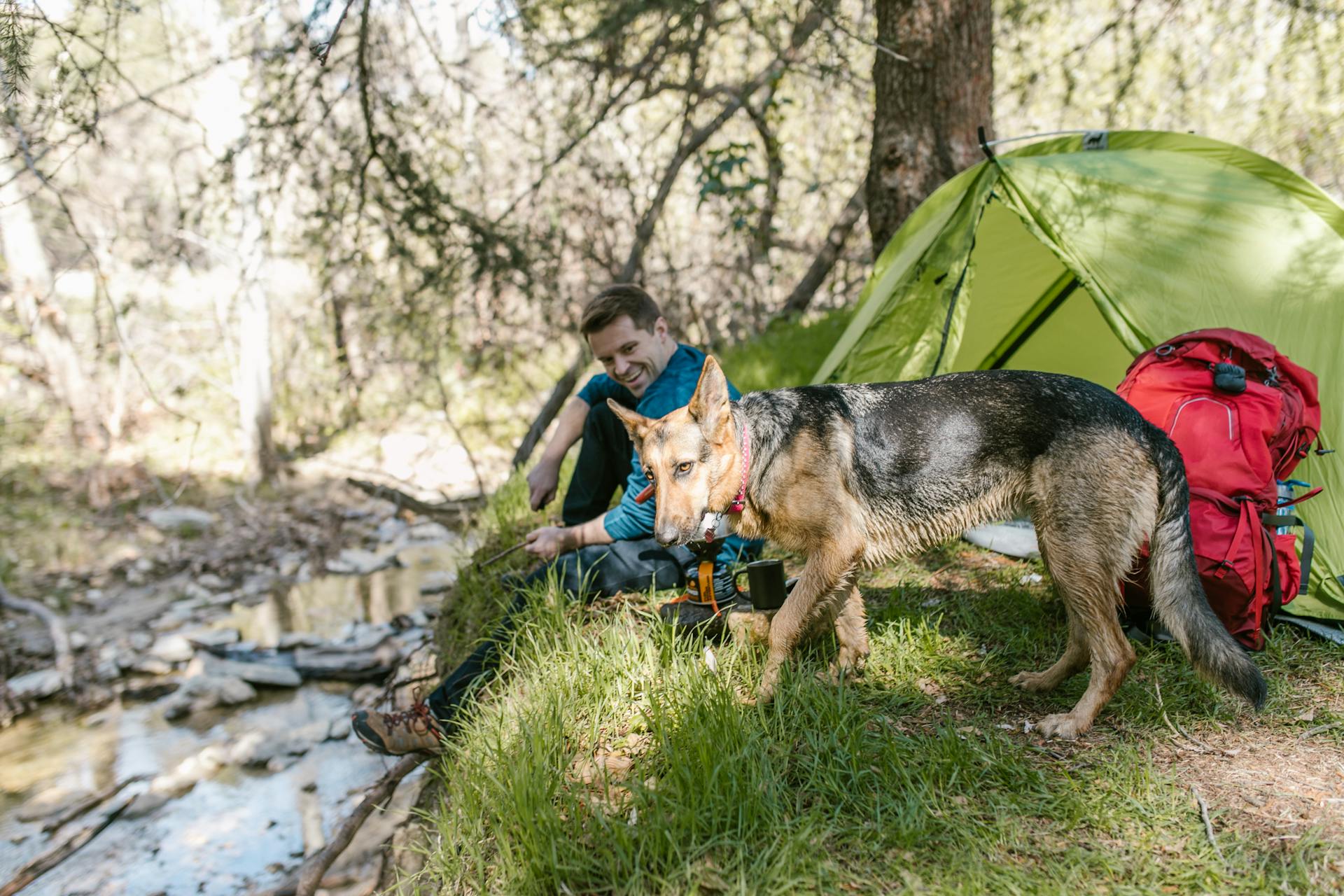
If you're considering keeping a German Shepherd outside, it's essential to think about the climate and region you live in. In warm and humid climates like Florida, German Shepherds can be at risk for heatstroke.
In areas with extreme temperatures, like Arizona, German Shepherds need extra care to stay safe. They require shade, water, and regular breaks from the sun.
German Shepherds can adapt to cold climates like Alaska, but they still need protection from harsh winds and freezing temperatures. They also need a warm shelter to come back to.
Their thick coats help them regulate their body temperature, but they still need proper care to stay healthy in extreme weather conditions.
Additional reading: How to Care for Female Dog after Spay
Temperature and Climate
German Shepherds can live outside, but it's essential to provide them with proper care and protection from extreme temperatures.
Their thick coat provides natural insulation, making them better suited for colder climates. German Shepherds can tolerate moderate heat, but they are prone to overheating and can suffer from heatstroke in extreme temperatures.
In hot weather, it's crucial to provide ample shade and fresh water, and avoid prolonged outdoor activities during the hottest parts of the day. German Shepherds can become exhausted and suffer from dehydration if left outside in the heat.
Some signs of coldness in German Shepherds include shivering, lethargy, weakness, decreased appetite, and seeking warm places to rest. If you notice any of these signs, it may be time to bring your dog inside.
Here are some steps to take during the heat to keep your dog cool:
- Provide ample shade and fresh water
- Avoid prolonged outdoor activities during the hottest parts of the day
- Monitor your dog's temperature and watch for signs of heatstroke
- Provide a cool, quiet space for your dog to rest
If you must leave your German Shepherd outside in the winter, ensure that they have access to a comfortable and warm shelter that is insulated and protected from the elements. The shelter should have enough room for your dog to move around and lie down comfortably, and provide warm bedding, such as blankets, to keep them warm and comfortable.
Leaving German Shepherds Outside
German Shepherds can be adaptable to colder temperatures and enjoy being outside in the winter, but it's not recommended to leave them outside for extended periods without proper protection and shelter.
Additional reading: Can Goldendoodles Be outside Dogs?
You should ensure that your German Shepherd has access to a comfortable and warm shelter that is insulated and protected from the elements. The shelter should have enough room for your dog to move around and lie down comfortably.
If you must leave your German Shepherd outside, check on them regularly and monitor them for signs of coldness, such as shivering or lethargy. Limit their time outside in extreme weather conditions.
As a general rule, it's recommended not to leave a German Shepherd outside in temperatures below freezing (32°F or 0°C) for more than 30 minutes to an hour at a time. If the temperature is colder than 20°F (-6.7°C), limit the time outside to no more than 10–15 minutes.
It's essential to monitor your German Shepherd's behavior and physical signs of discomfort, such as shivering or lethargy, and bring them inside if they exhibit these symptoms. Provide them with fresh water and food, and ensure they have access to a warm and insulated shelter.
In most circumstances, you can leave your German Shepherd outside if you have the proper setup, including shelter and water. However, you still need to spend time with your German Shepherd, even if they are outside most of the day.
Explore further: Pitbull Dog Signs
Dog Health and Safety
German Shepherds can adapt to colder temperatures, but it's not recommended to leave them outside for extended periods without proper protection and shelter. They can be susceptible to hypothermia and frostbite, especially in extreme cold.
To keep your German Shepherd safe, ensure they have access to a warm and comfortable shelter that's insulated and protected from the elements. This should have enough room for them to move around and lie down comfortably.
Signs of coldness in German Shepherds include shivering, lethargy, weakness, decreased appetite, and seeking warm places to rest. If you notice any of these signs, it's essential to check on your dog regularly and provide them with fresh water and food.
Here are some essential things to consider when leaving your German Shepherd outside:
- Shelter: Provide a warm and insulated shelter that protects them from rain, wind, and extreme temperatures.
- Access to water: Ensure your dog always has access to fresh water.
- Regular checks: Monitor your dog's behavior and check on them regularly for signs of coldness.
- Time limits: Limit your dog's time outside in extreme weather conditions.
In general, it's best to keep your German Shepherd indoors with you during cold winter weather to ensure their safety and well-being.
Regional Considerations
German Shepherds can thrive in various climates, but some regions require special consideration.

In Florida, the temperature remains relatively moderate, ranging from 69.8 to 77 degrees Fahrenheit, making it suitable for German Shepherds with proper care.
German Shepherds can also live in Arizona, where the temperature is likely to be even hotter than in Florida.
However, it's essential to note that extreme temperatures, regardless of the location, should be avoided to prevent heatstroke and other health issues.
You might enjoy: Alaskan Malamute Temperature
Florida
Florida has a relatively mild climate, especially in the summer when temperatures range from 69.8-degrees Fahrenheit to 77-degrees Fahrenheit.
This means that with proper care, your German shepherd can thrive in the state's moderate weather year-round. German shepherds can indeed live in Florida.
California
California is a great place to consider for your German Shepherd, with its relatively friendly climate. The average summer temperature is 78.8-degrees Fahrenheit, making it perfect for a dog that loves to stay active.
The state's winter temperatures vary between 9-degree Celsius to 68-degrees Fahrenheit, and it rarely snows there. This means that California's weather stays friendly throughout the year.
Frequently Asked Questions
How cold is too cold for German Shepherd to sleep outside?
For German Shepherds, temperatures below 20 F (-7 C) can be hazardous, so it's best to bring them inside or provide a warm, sheltered area to prevent cold-associated health issues.
Sources
- https://www.dogslife.com.au/dog-breeds/german-shepherd
- https://medium.com/@fitonear/can-german-shepherds-live-outside-in-winter-e41e560d4733
- https://germanshepherdshop.com/blogs/list/cooling-tips-for-german-shepherds-how-to-beat-the-heat-in-hot-weather
- https://dogmomhub.com/german-shepherds-hot-weather/
- https://www.hepper.com/do-german-shepherds-get-cold-outside/
Featured Images: pexels.com


